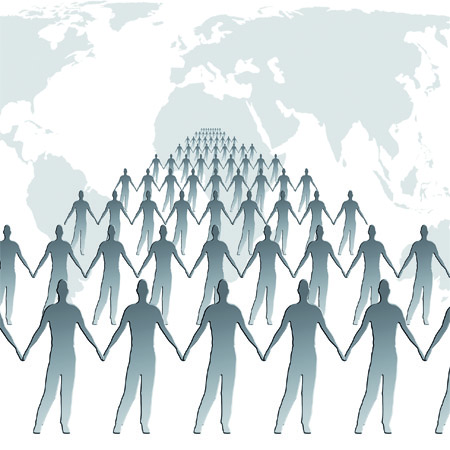This “fact” was repeated in many places recently when the world’s population reached the seven billion mark. It was a significant moment and some sought to emphasise the population explosion by repeating this startling piece of information. For the statement to be true, however, there would obviously need to be fewer than seven billion people who have previously lived and died in the history of humanity.
If you look at the statistics then at first this appears to be a plausible theory, given the huge population spike in recent times, as illustrated by the graph (below) with data up to the year 2000.
But the sheer span of time before the spike negates its dramatic upsurge. There is no population data for that vast period so we’re just working on fair assumptions, and first you have to decide where you are starting from. The general scientific consensus puts humans as having been around for 50,000 years — our ancestors prior to that were not Homo sapiens. With this in mind, it’s estimated by the Population Reference Bureau in Washington DC that there have been 107 billion people, which makes a ratio of one living person for every fifteen who have died, disproving the “fact”.
Professor of Earth and Environmental Science at Columbia University, Joel E Cohen, agrees that far more people have been born than are currently alive: “The estimate of the Population Reference Bureau that the number ever born is about 107 billion people has a large margin of uncertainty — my own research estimates 70 to 80 billion and even that range is uncertain. Nevertheless, it’s very clear that the number (let’s say, somewhere between 70 and 110 billion people) far exceeds the number now alive.”
It’s interesting to note that in 1968 Arthur C Clarke stated in his seminal novel 2001: A Space Odyssey that “behind every man now alive stand thirty ghosts, for that’s the ratio for which the dead outnumber the living.” When you factor in that he was writing this in the late 1960s, when the global population was 3.5billion, the ratio works out as one living for every 29 dead, meaning he was pretty much spot on.
So, in the late 1960s it was a 1-to-29 ratio and now it’s a 1-to-15 ratio, but will there ever be a point where it’s a 1-to-1 ratio? That would require there to be more than 107 billion people living on the planet.
“It seems extremely unlikely that we could ever have 70-110 billion people alive on Earth at any time,” says Professor Cohen. In his 1995 book, How Many People Can the Earth Support? he stated that most estimates of Earth’s human carrying capacity were in the range 7-12 billion. “I don’t think it’s likely that the number of people alive will ever get close to the number of people who have been born. Nobody knows the highest population the Earth could sustain, but that is not a number that matters. What matters is how many people can live well, with enough material resources, with dignity, and with meaningful lives.”
As population growth figures have been published there have long been fears of global overcrowding. And when there are fears, there usually follows nonsense presented as fact to fuel that fear. During the 1970s there was a similar rumour claiming that seventy-five percent of all the people ever born were on the planet living at that time. This was also wrong. So why do these rumours start?
“A possibility is that some people suffer from historical myopia,” Professor Cohen explains. “The population of the Earth doubled in roughly the last thirty-five or forty years. If you pretend human population doubles every generation, based on the experience of the most recent generation, then you could believe that the number of people now alive exceeds the number ever born.
“For example, if you start with two people, a generation later you would have four people (more than the two people who had ever been born before that generation). A generation later you would have eight people, more than two plus four. Another generation later you would have sixteen people, more than two plus four, plus eight. And so on. The only trouble with this theory is that it takes fewer than thirty-three generations to reach a population of about eight and a half billion. If you accept roughly three generations per century, then Adam and Eve lived about eleven centuries ago. If people thought about it, I think they would find this implausible.”
The professor also postulates that there is perhaps a simpler reason for people continuing to perpetuate this myth: “Facts really have little to do with what people believe.”

